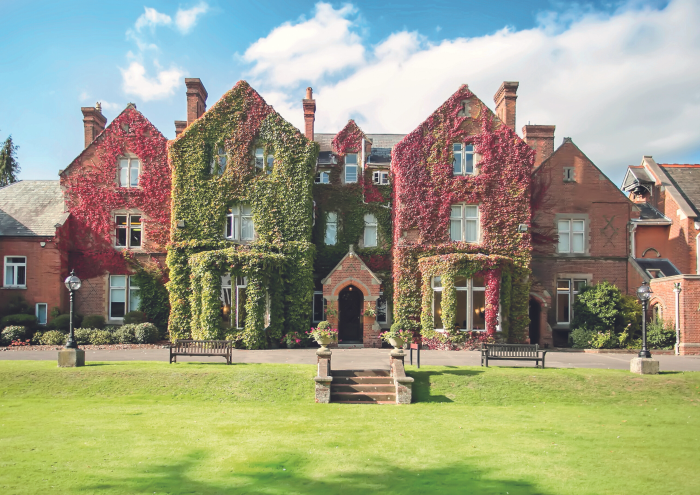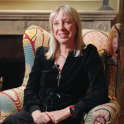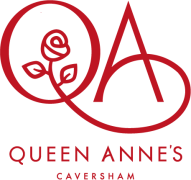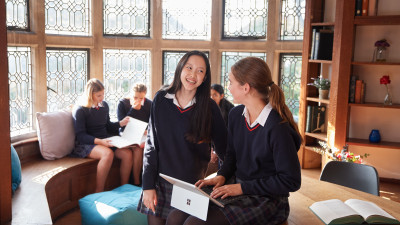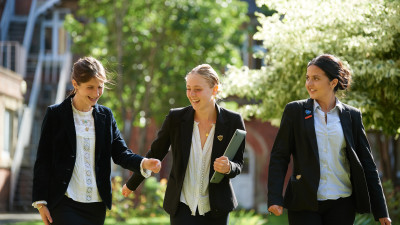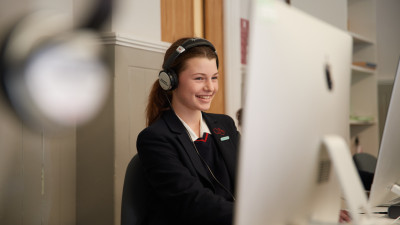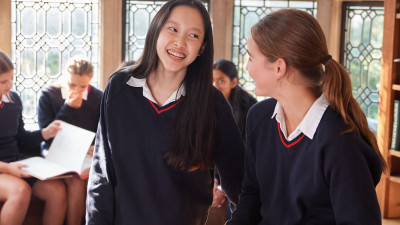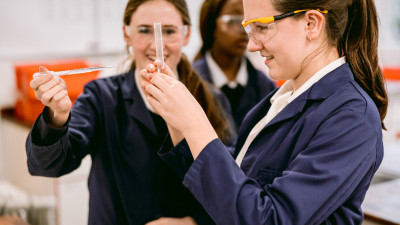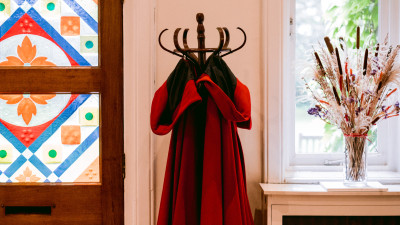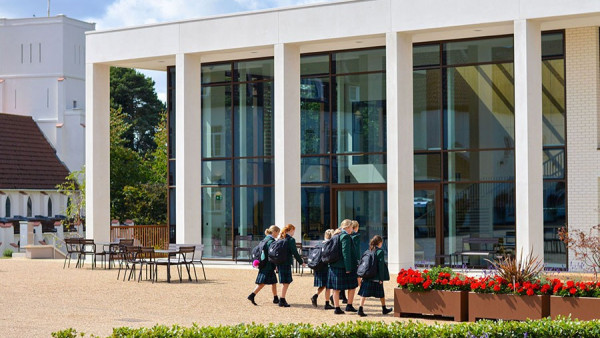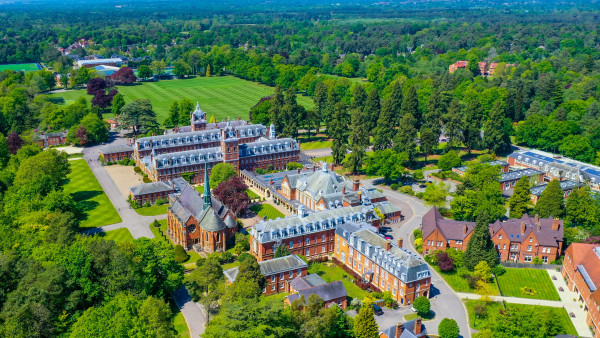Arty, sporty, gently academic school with an oddly subdued public image. Tradition meets futuristic in its embrace of digital education and the very wide range of subjects and activities on offer. Outstanding music. ‘We need to get better at conveying how much is happening here,’ says the head. ‘If anything, there’s almost too much going on!’
Why read our school review?
Unlike other websites, schools can't pay to be included in The Good Schools Guide. This means our review of this school is independent, critical and fair, and written with parents' best interests at heart.
Overview & data
- Pupil numbers
- 361 ·
- Sixth form numbers
- 127 ·
- Offers boarding
- Yes ·
- Religion
- C of E
- Fees
- Day £27,360 - £32,199; Boarding £52,131 - £53,829 pa
- Local authority
- Reading Borough Council
- Area guides
- School ownership
- The Westminster Grey Coat Hospital Foundation
Headteacher
Head
Elaine Purves
Since 2022, Elaine Purves. Read English and German at Hull before completing a PGCE at Durham. Began her teaching career at Oakham School, then on to the Royal High School, Bath, where she was deputy head. Amazingly, Queen Anne’s is her fourth headship after Ipswich High School, Rossall School and, most recently, St John’s International School in Belgium. Tall, willowy and ‘approachable’ with an appearance strongly reminiscent of mid-eighties Jessica Lange. Hired during Covid via Zoom interview and agreed to take over the reins at Queen Anne’s ‘sight unseen’.
When not headmistressing, likes meeting new people, travel, cycling, and playing golf with her children. Is fluent in German and has now set herself the task of learning French. Married with two children – son is reading law at Durham and daughter is doing the IB at a nearby school. A big fan of the IB herself, but no current plans to introduce it here. Does hope to develop the school’s ‘global outlook’ and stretch the confines of GCSE and A level exams. List of A level subjects offered has recently lengthened quite excitingly.
Entrance
The 11+ assessment day in October prior to year of entry includes a written English paper, online maths and reasoning papers, plus a bit of fun so girls can get to know the school. For 13+ entry girls sit old-school CE papers in maths, English and science, plus reasoning. Sixth form entry involves November entrance exams in maths and English plus a requirement of minimum six GCSEs at grade 6 or above, including any subjects to be studied here.
- Open days
- Open mornings September, March, May
Exit
Just under a quarter head off after GCSEs in search of co-ed sixth forms or to local colleges. Those who stay move on to an unusually wide range of good UK universities (mostly Russell Group) to read just about everything under the sun, eg politics, fashion management, medicine, law, physics with astrophysics and international business. Cardiff, Birmingham, Exeter, Durham and Newcastle have all featured recently. One to Oxbridge in 2025. One joining Amazon's degree apprenticeship programme.
Latest results
In 2025, 69 per cent 9-7 at GCSE; 47 per cent A*/A at A level.
A levels or equivalent - Average points score (2024)
What is this?
These figures tell you the average grade and average points that pupils achieved in their academic qualifications. A maximum of 60 points are available for a grade A* at A level.
Teaching & learning
Unlike many independent schools we visit that take a perverse pride in offering a rickety list of near-Dickensian academic subjects, QA has embraced the future. A level options now include animation, criminology, dance, environmental science, film studies, media studies, music tech, psychology and sociology. The GCSE programme is a bit less exuberant, and all pupils do core subjects of maths, English language, English literature and triple science. Still, GCSE options include dance, textiles and Mandarin (French, Spanish, German also offered). No DT. Younger girls have a chance to have a go at a full range of subjects; setting in maths and science.
And the results? Psychology now the most popular A level, with superlative results: 86 per cent A/A* in 2021. Heavy hitters like maths, chemistry and biology also attracting high numbers and good results. Less orthodox subjects have yet to filter through to exam results – will be interesting to see how this plays out. Tiny numbers doing GCSE or A level textiles or dance (school points out textiles is commonly built into art A level). But art (A level and GCSE), drama and music (GCSE) are phenomenally strong and popular. Surprisingly few takers for languages, with no girls sitting Spanish or German A levels in 2021 (two German, two French and three Spanish in 2022). Geography popular, and when we visited girls were buzzing about Queen Anne’s geography department hosting a dinner with Eton geographers. School trips are roaring back to life post-Covid. School provides overall exam results, rather than separating by subject, so worth asking for a breakdown if a particular subject is important to your family.
Brilliantly switched on to digital technology: not for nothing is this a three-time Microsoft Showcase School! Every pupil has a ‘device’ which is brought to all lessons, and all work is on OneNote, including textbooks. So, when Covid hit, Queen Anne’s was superbly prepared to transition to remote learning. Meanwhile, the scholars’ essay competition encourages writing without depending upon the internet. We loved the inventive topics the girls came up with, eg ‘In which industries could Mycelium-based products have the greatest impact?’ and ‘Digital Devices: Progress or Pro-stress?’
Older girls told us they would bring back ‘drop-in clinics’ – extra coaching sessions in individual subjects. A mum agreed, adding, ‘The school’s academic reputation is good, but it could do more, and academic clinics would go a long way.’ BrainCanDo, the previous head’s psychology and neuroscience pet project, is being quietly eased out. School says: the educational neuroscience approach to teaching and learning remains.
Geography popular, and when we visited girls were buzzing about Queen Anne’s geography department hosting a dinner with Eton geographers
- Qualifications taken in 2024
- A level
- EPQ
- GCSE
- VRQ
Learning support & SEN
Although 69 girls, around 15 per cent of pupils, have some form of SEN, none of them has a statement. One-to-one support with specialist teachers is available at extra charge. Maddock and Holmes boarding houses have lift access, and room allocations and timetabling can be tailored to accommodate anyone with mobility issues. ESL coordinator runs EAL course in small groups of no more than six pupils.
Arts & extracurricular
The arts here all shine, but music is positively luminous. ‘The music department is amazing,’ gushed our guides who also wanted us to mention that ‘a boy from Reading School took his A level music here!’ Over 50 per cent of girls learn at least one instrument and some learn more than one. And we’re not talking maracas and recorders. Jaw-dropping, proto-conservatory standards are reached: 12 girls had taken diplomas at ARSM/LTCL level in the academic year when we visited. Brava! Music lessons are sensitively scheduled to avoid missing academic lessons when possible. There are two choirs, a string orchestra, jazz, sax and clarinets. We enjoyed the lovely acoustics of the two recital halls and admired the Mac suite, recording studio and 16 practice rooms.
The school’s Performing Arts Centre (PAC) is a modern, purpose-built space with over 250 permanent seats (plus scope for temporary seating). There are four productions each year, and Queen Anne’s girls recently collaborated with Reading School to produce five full-scale performances of Les Mis. All pupils do drama in years 7 and 8, loads take it for GCSE and A level, and nearly 100 girls are involved in LAMDA examinations.
Fine art abounds in several large studios (including a kiln) plus a textiles room (32 girls take part in the Tuesday afternoon textiles activity; a few carry on through to A level). Every year Queen Anne’s art students enter the Royal Academy’s Young Artists’ Summer Show. Animation has been offered as an A level since 2017.
DofE big: a whopping three quarters of the girls take part, with 30 gold awards over the past five years. Ninety-minute lunch period supplies ample time for socialising and a huge slate of activities, eg ceramic art therapy, Digigirls, bee keeping, cookery and orchestra. Other activities happen on Queen Anne’s three long days that run to 6.15 (school finishes at 4.30pm on the two remaining days; no Saturday school).
Jaw-dropping, proto-conservatory standards are reached: 12 girls had taken diplomas at ARSM/LTCL level in the academic year when we visited. Brava!
Sport
In the many-threaded tapestry of Reading independent education, Queen Anne’s is known as the ‘sporty’ school, both regarding its facilities and its talent on the games pitch. Super sports facilities include a 25-metre pool, fitness suite, sprung-floor dance studio, climbing wall, squash courts, plus loads of tennis and netball courts. Thanks to a big push from the new head, the long-term goal of leveling the lacrosse pitch is finally moving off the wish list and into reality, along with resurfacing tennis courts and investing in floodlighting.
Lacrosse ferociously good, with county and national players (three girls on the national team when we visited); netball too. Girls say Downe House is the sporting arch rival. Rowing and football are newer additions and so far, so strong. Also competes at tennis, cross-country, athletics, swimming, cricket and trampolining. No hockey. Two double lesson sessions of sport each week. Fixtures for everyone in years 7 and 8, and from year 9 there are still C team matches most weeks, ‘My daughter struggled with sport initially,’ a mum of a year 10 girl told us. ‘She wasn’t naturally sporty in years 7 and 8, but now she’s on teams and very involved.’
A wonderful choice for girls keen on dance. Dance is offered at every standard, from extracurricular clubs through to A level. ISTD dance lessons in ballet, tap and modern up to vocational level. Also jazz and street dance.
Queen Anne’s is known as the ‘sporty’ school, both regarding its facilities and its talent on the games pitch
Boarders
Full and flexi boarding has a cherished place in pupils’ warm memories of the school. Some old girls told us the boarding houses have been cavalierly sliced and diced in recent years, but we think the newest sculpting may have settled on an optimal arrangement. Mitchell, the former sixth form house at the end of the games pitches, has been transformed into a junior ‘retreat’ for years 7-9. Girls sleep in singles, twos and threes. Loads of ‘sits’ and snugs. The Big Sit – bright, light and tastily kitted out in orange and teal, is a lovely gathering place for house meetings… or a Saturday night takeaway. The Zen Zone has comfy sofas and a pool table. There is a kitchen for cookery activities, and girls can bring in favourite foods. Houseparents have two daughters who have been through the school, and two dogs. Indeed, the school is a veritable Dalmatian plantation, with up to 20 well-behaved teachers’ pooches right at home here.
Years 10-13 now based in three mixed-age houses in the heart of the school ‘close to everything', say the girls. These houses are similar, but Holmes rooms are ensuite. Year 10s in triples; older years mainly in doubles and singles. We admired the well-appointed kitchen and prep room with computers (prep mainly done in classrooms in younger years; in dormitory rooms from year 11 onwards). Weekend trips to London and to local entertainments. A parent of a full boarder told us the weekends work well – ‘she always has good friends there in the boarding house.’ Girls can walk into Reading on Sundays or have a range of outings, eg theatre, trampoline, cinema, bowling.
Ethos & heritage
Established on its current site in 1894, Queen Anne’s is part of the United Westminster Greycoat Foundation founded in 1689 by eight merchants in Westminster. Girls still attend a biennial service at Westminster Abbey bedecked in the school’s famous red cloaks (which mostly gather dust except on special occasions).
For many locals, the front perimeter wall, along a leafy suburban street, presents a mystery. ‘We always wondered what went on behind the wall,’ one pupil told us. The answer is a Tardis-like 35 acres of school grounds and elegant facilities. We’re not talking the usual maze of low-rise horrors from the decades that architecture forgot, but a gracious collection of buildings immediately adjoining playing fields and boarding accommodation. School’s motto changed in 2019 from Quietness and Strength (eek) to Kind Hearts, Fierce Minds, Strong Spirits (now, that’s more like it). We’re not quite sure what strong spirit means, but we did detect a purposeful serenity here that eludes some girls-only schools.
The crisp new main entrance and reception desk backs on to the music department with lilting piano, cello or flute filtering gently through as the first impression visitors receive. The Space, home of the newish (2016) sixth form centre and dining hall, feels like an office building from Starfleet Academy. Its Café 6, a bright, stylish in-house eatery, serves hot snacks and proper coffee to sixth formers who relax in leather-upholstered booths or outside in their own charming courtyard area. Atop are flexible classroom spaces and brilliantly styled breakout rooms decorated in the theme of eg Central Park (AstroTurf carpet, skyscraper mural and park benches), Big Ben or musical theatre. Other highlights are a well-provisioned science centre (eight labs) and a lovely sunken octagonal library. History and classics are, appropriately, taught in the oldest part of the school. Smart and tasteful year group ‘sits’ – cozy common rooms – sprinkled throughout the school.
Founded in
We’re not talking the usual maze of low-rise horrors from the decades that architecture forgot, but a gracious collection of buildings immediately adjoining playing fields and boarding accommodation
Pastoral care, inclusivity & discipline
Girls now grouped, Sorting-Hat-style, into one of five new ‘charters’ (similar to houses) named after female historical figures – these are a direct spin-off of the pupil bubbles created during Covid. Wellbeing programme has replaced PSHCE and is delivered by a dedicated team to tutor groups in years 7-10, covering issues such as relationships, friendship and social media. Peer mentors are on hand for wisdom and warmth – ‘Girls take advice best from other girls,’ our guide explained. Nurturing of confidence and self-belief a priority here: ‘Her confidence has shot up,’ a mum said of her year 10 daughter. ‘It is 100 per cent because of the school. She wasn’t always like this.’
Phones are put away in phone lockers at the start of school day until the end of lessons. Younger boarders hand them in again before bedtime. From year 10 they can be kept until morning, but it’s a hollow victory as wifi is turned off at 10pm (11pm on weekends). Good, straightforward food, and girls must hand in a ticket at the tuck shop to show they’ve eaten before they can buy tuck. Whole-school assemblies every Monday in the old-school-style assembly hall. Chapel every other week. Sixth form girls are treated with the respect that befits their age and are expected to wear ‘smart work wear’. Trousers are a uniform option in all years.
International pupils bring a welcome dash of diversity, including three girls arriving from Ukraine. Staff took part in equality, diversity and inclusion training around the time of our visit: ‘Equipping staff with tools and techniques to create safe spaces and open up effective conversations about race, identity and racism with young people.’ We’re a little puzzled by the amount of regulatory information on the school website: how many other schools have an Anti-Modern Slavery Policy, a Counter-Terrorism Policy and a Most Able Policy – all displayed proudly among their ethos and aims?
Mobile phone policy
A clear mobile phone policy is a really important part of modern schooling. This school has provided us with their policy.
Mobile phone policy
We have a graduated approach to mobile phones in the school, which ranges from the younger students handing their phones in each morning and collecting them before they leave in the evening, through to the U5th and sixth form students who are expected to be more responsible for their own behaviour whilst using their phones. In the boarding community, technology is collected in overnight, up to and including the 5th form boarders, to help aid them with their rest and sleep.
Pupils & parents
Girls join at 11 (and 13) from a large number of local-ish prep schools and state primaries; boarders from 23 different countries including Forces and expats; some weekly boarders from London (weekly coach service to and from). Transport network stretches across Berks and Oxfordshire and into Surrey and Bucks. London Paddington a 26-minute train ride away; 40-minute drive to Heathrow.
Some parents now see the school as an opt-out of the scary senior school entrance competition in London (‘a refuge for girls who don’t get into London day schools,’ said one past parent uncharitably). Ditto girls who don’t pass muster with the local grammar school exams. Perhaps, but most families we spoke to had positively chosen QA, often despite having been offered a place in a grammar school. ‘My daughter wanted to board,’ said one parent who turned down Kendrick. ‘She did her own research. When we went to visit, if felt kind, it felt different, and she said: “This is my school”.’ Bound to feel a bit of pressure from local boys’ school Reading Blue Coat moving to full coeducation, but the offering here is different enough (girl-centred, boarding) that we are bullish!
Money matters
Boarding fees in line with local competitors. Day fees not too painful considering extended school day and access to some boarding perks. One of a shrinking number of schools where scholarships are more than mere honorifics: the top academic scholarship each year can knock 25 per cent off day fees. Awards also for art, music, drama, sports and all-rounder at 11+, 13+ and 16+. Discounts for siblings and for Forces families, and a few means-tested bursaries are available; ambitious plans afoot to expand their Red Cloak Awards offering transformational 100 per cent bursaries.
- Fee information
- Day £27,360 - £32,199; Boarding £52,131 - £53,829 pa
The last word
Arty, sporty, gently academic school with an oddly subdued public image. Tradition meets futuristic in its embrace of digital education and the very wide range of subjects and activities on offer. Outstanding music. ‘We need to get better at conveying how much is happening here,’ says the head. ‘If anything, there’s almost too much going on!’
